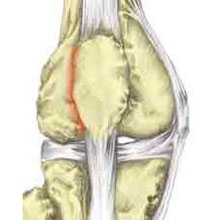Patellofemoral Pain Syndrome

Patellofemoral Pain Syndrome (PFPS) also known as runner’s knee, chondromalacia patellae, anterior knee pain and patellofemoral joint syndrome is a generic term used to describe patella pain at the front of the knee.
Symptoms
The onset of anterior knee pain is usually gradual. Symptoms include an aching pain in the knee joint, particularly at the front of the knee around and under the patella. There is often tenderness along the inside border of the kneecap and swelling will sometimes occur after exercise.
Patellofemoral pain is often worse when walking up and down hills/stairs, during body weight loading of the lower extremities, jumping, squatting, kneeling, and sitting with knees flexed. Overuse further exacerbates Patellofemoral pain, as well as long car rides or sitting for long periods of time.
Other signs you may pick up on include a click or cracking sound when bending the knee.
What is patellofemoral pain?
PFPS occurs when the patella (kneecap) rubs on the femur bone underneath. It is often thought that incorrect tracking or rubbing of the patella over the femur bone is a significant factor and results in damage or irritation of the articular cartilage underneath the patella.
Patellofemoral pain is common in people who do a lot of sport and in particular adolescent girls. It can have a number of causes but damage to the cartilage itself cannot directly cause pain because there are no blood vessels or nerves involved. However it can lead onto other problems which in turn result in pain. These include synovitis (inflammation of the synovial membrane or joint lining), erosion of the cartilage and bone under the patella, soft tissues injury or irritation for example to the lateral retinaculum and the infra patella fat pad.
The initial cause of patellofemoral pain syndrome is likely to be overuse.
This may be from external factors for example a sudden increase in training, or performing high intensity jumping and knee bending, or it can be from internal factors such as poor patella tracking. Identifying the cause is an important part of treatment.
Biomechanics of PFPS
Taking a closer look at PFPS reveals the internal structures involved in this condition and their impact on pain in the anterior knee.
Of particular interest are :
Lower limb muscle imbalances
Overuse and repetitive weight-bearing activities
Arch variations (flat, high)
Wider hips and knock-knees (Q-angle)
Muscle imbalances may be responsible for poor patella alignment. Usually, the patella moves up and down as well as tilts and rotates through the trochlear groove in the distal femur as the knee flexes and extends. As compression between the patella and the groove increases pain can happen in and around the joint. Over time, this misalignment causes the cartilage to wear down as the patella and the head of the femur rub against one another. Much of the pain associated with this condition is due to the accumulation of inflammatory waste products from the friction, which leads to swelling and further damage to the joint’s synovial lining.
Patellofemoral Pain Syndrome Treatment
Patella pain treatment and rehabilitation is based around reducing symptoms, identifying the causes then re-training muscles which may have contributed to the injury.
Sports Massage can help loosen tight structures and muscles which may be contributing to the tightness and misalignment . Kinesio taping is an excellent technique to control the position of the patella and relive pain symptoms.
Researchers have confirmed that massage intervention is a very effective solution for kneecap pain. Int J Ther Massage Bodywork. 2014 Sep 3;7(3):25-31. eCollection 2014 Sep.
Approximately 90% of patellofemoral syndrome sufferers will be pain-free within six weeks of starting a sport massage rehabilitation program for patellofemoral pain syndrome.
You’ll find that in most cases, attempting to progress too soon can lead to re-injury and the frustration of a delay in your recovery.
Contact me today for an appointment or more information.